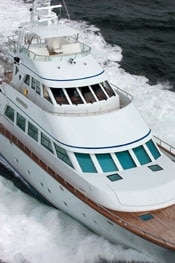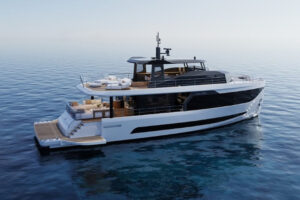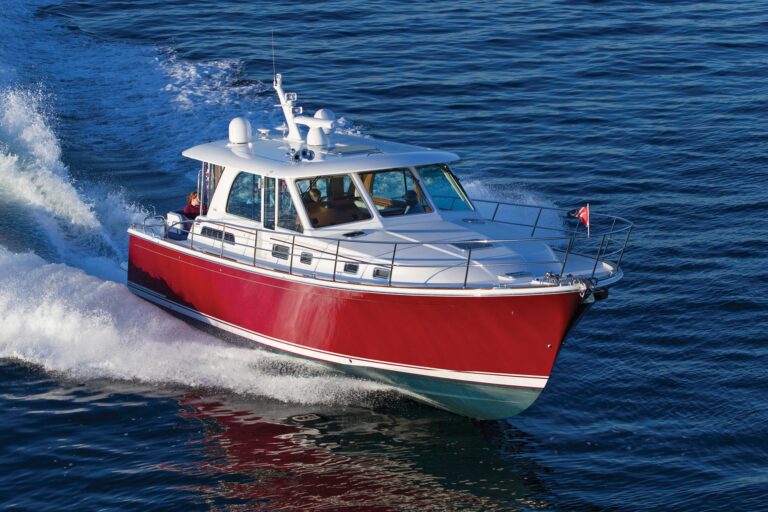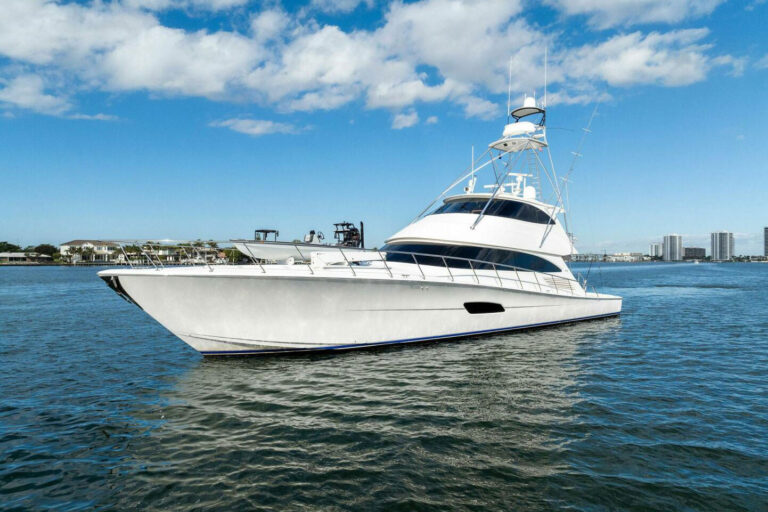
Heesen 105
Marlin and sailfish. Yellowtail, bass, barracuda, bonito. What sounds like a platter of sushi in one context becomes altogether more exciting when you propose to catch these fish yourself. That’s why the perfect blend of yachting and something to do has to be sportfishing. There’s just something stirring about man’s most cunning and beautiful designs chasing nature’s own best of class-the superb gamefish that prowl the depths.
At 105 feet, Karyatis, the Dutch-built Heesen, sits at the pinnacle of this food chain, purpose-built for quarry and for comfort. Sportfishing, as practiced around the world and perfected in the waters that surround the U.S., demands a very different and specific style of yacht, one that’s designed to linger in conditions and attitudes that a cruiser would sooner pass by.
But a sportfishing boat the size of Karyatis almost redefines the genre, because she is also a cruising yacht. For instance, where a vessel this size would generally have a wheelhouse and a flybridge, aboard Karyatis there are six steering stations. Two of them face astern and overlook the cockpit, offering skybox views of the fishing arena, for it is here that a skillful captain demonstrates the leadership and yacht-handling skills that make all the difference. His reputation rests on what his party brings back at the end of the trip.
Heesen is well acquainted with world-class sportfishing boats, having built Obsession in 1996, at 125 feet then the largest in the world. She had a top speed of 33 knots and dominated the scene in both speed and size. She was the first private yacht fitted with interceptors, a Russian invention used to stabilize high-speed craft that is now common aboard European yachts. Interceptors are essentially vertical sliding plates in the transom; when lowered at high boat speed, they create a wedge of water that acts like a trim tab. In 1999 Obsession was superceded by Red Sapphire, which, at 128 feet and capable of 34 knots, is one of the world’s largest sportfishermen.
Now comes Karyatis, named for the Caryatids-the legendary young women of Sparta who danced every year in honor of Artemis Karyatis, the daughter of Zeus and goddess of the hunt and wild animals. They are immortalized on magnificent buildings all over Greece and are those stately young women who hold up one wing of the Erechtheion, on Athens’ Acropolis, with their heads.
Pieter Beeldsnijders and Heesen’s in-house naval architects designed Karyatis as a semi-displacement, hard-chined yacht capable of 30 knots. The architects opted for propeller pockets to accommodate the massive props necessary to push the yacht to her design speed without creating excessive draft. Propeller pockets also allow the propellers to run very efficiently, and very slowly, to reduce both cavitation and turbulence that could hamper fishing. Conventional trim tabs help smooth out the ride at the high speeds needed to reach the fishing grounds. Changing their angle maintains slow-speed stabilization while trolling. There’s a bowthruster in a tunnel, and a drop-down sternthruster, which helps when landing large gamefish through the transom door.
On deck, the Heesen is all machine, built to bite into head seas. Sturdy handsome bulwarks shield the foredeck, mooring bitts, twin capstan and anchor windlasses from the elements. An under-deck garage hides a 12-foot inflatable tender; deck hatches reveal spacious and secure stowage for lines and fenders.
From the flybridge the true potential of this fish-catching machine can be appreciated. It is an aerie with a commanding view of the foredeck. Yet turn around and just a single stride ensures you have full sight of the fighting deck. Controls are duplicated at either end of the flybridge, facing forward and aft to ensure the captain retains control, no matter what drama is going on below.
One deck below is a pretty Portuguese bridge and a sky lounge for guests. Just forward of the lounge is the helm area, a fully integrated computerized control station where the captain can operate every aspect of the yacht’s facilities. Six large flat screens call up radar, electronic charts, CCTV, the forward-looking fish-finder and echo-sounder displays. And the guests in the sky lounge just aft have a full view of the action: rather like watching your sushi chef at work at a tableside restaurant in Tokyo. A large table and a huge 43-inch plasma screen TV dominate this area, which has a handy wet bar and bottle fridge. Say the word, though, and the big screen drops into a locker inside the table, which then can be used to serve lunch or dinner to guests who prefer to eat in the command area. Outside the glass double doors on deck, another smaller table serves for alfresco dining. An upper control station on the same deck faces aft, overlooking the cockpit. And controls are duplicated one deck up on the flybridge and again on each side just outside the bridge doors.
On the cockpit deck, a wide split-level expanse of teak, is the yacht’s amphitheatre, or in keeping with the Greek theme, her agora; in any event, it is the setting for a Pompanette Jumbo fighting chair, the focal point for any piscatorial gladiator action. Three stainless-steel outriggers, one on either side and another in the center, allow an expert angler to create a lure pattern irresistible to trophy gamefish; more than 30 lures can be deployed. Once a fish is hooked, the captain can play it from one of the two steering stations that look down on the cockpit.
When not fishing, Karyatis’ rods can be stowed in custom brackets located in lockers accessed by large liftup hatches in the deck. This gear locker runs the full beam of the boat, and houses bait wells, freezers for catch and bait as well as stores, rods and reels; the yachts’ fishing gear is said to cost well over $100,000.
A second under-deck locker provides stowage for the shoreside cable drum and hydraulic power packs, together with the custom carbon-fiber gangway that gets mounted on special stainless steel brackets to avoid damage to the teak caprails. The same space houses the emergency steering position: Yes, Karyatis has yet another steering station below the cockpit sole, almost on top of the rudder posts, for those annoying times when the main steering fails. No, the helmsman cannot see from here, so he needs another pair of eyes to keep watch and relay steering orders when necessary. But it’s a lot safer and more precise than steering with the engines, or using the old sailors’ trick of dragging buckets on one side or the other to persuade the vessel to turn. Emergency stations like this are unusual to find in a yacht of only 105 feet; they are more common aboard vessels twice as large.
But man does not live by fishing alone, and aboard Karyatis life is good when nary a line is wet. Double-glass sliding doors lead from the cockpit into the main saloon, opening at the touch of a button to reveal a stunning open-plan space. There are no bulkheads in this area, a requirement that presented significant problems to designers and builders who needed to move conduits and cabling from one deck to another. The large open space creates a lounging area with clubby leather armchairs, a separate owner’s office abaft the galley, bar, day head and dining room. Alderwood joinery with pear and burled maple accents, lots of leather and stone countertops are the thematic elements of the masculine interior, which is lightened by frosted and etched glass panels.
The massive clear glass windows have no curtains; instead, discreetly hidden blinds shield the saloon from outsiders when alongside a dock. This contributes to the light and airy feel of this spacious area, which at night is equally well lit by 100 deck lights as well as other indirect lighting. The entertainment package aboard provides superior audio and visual equipment ranging from 50-inch high- definition plasma-screen TVs with DVD and surround sound, to audio selections controlled by handheld remotes. When the fish aren’t biting, there will be other options.
From the after end of the saloon, open stairs lead up to the bridge deck. A second set of stairs leads down one deck to cabins for six guests. The full-beam owner’s stateroom and adjacent head is aft. Each of the two guest cabins has twin beds, en suite heads and 20-inch LCD TVs. Forward of the guest accommodations, through a watertight door, are three crew quarters opening onto a crew’s mess, large enough to seat Karyatis’ complement of four very well treated crewmembers.
The well-designed engineroom houses twin MTU 16V4000 M90 diesels and two Northern Lights 65kW generators. Fuel polishers to clean and filter diesel fuel from dubious sources, a pair of 1400 gpd Sea Recovery watermakers and a high-capacity sewage-treatment plant give the yacht the capability to go anywhere, do anything, and do it right. She has an extreme cruising range of 3,000 miles on 5,280 gallons of fuel.
Underway, this Greek dancer behaved well in all weather conditions, taking seas in stride and throwing aside swells with her well-flared bow as we belted along at nearly 30 knots. In calm water at slow-speed, her twin diesels growl with mucho machismo-but Karyatis doesn’t need that kind of showoff stuff. Built to go fishing, she’s in her element prowling the high seas.
Contact: Heesen Yachts, (011) 31 412 665544; www.heesenyachts.nl








